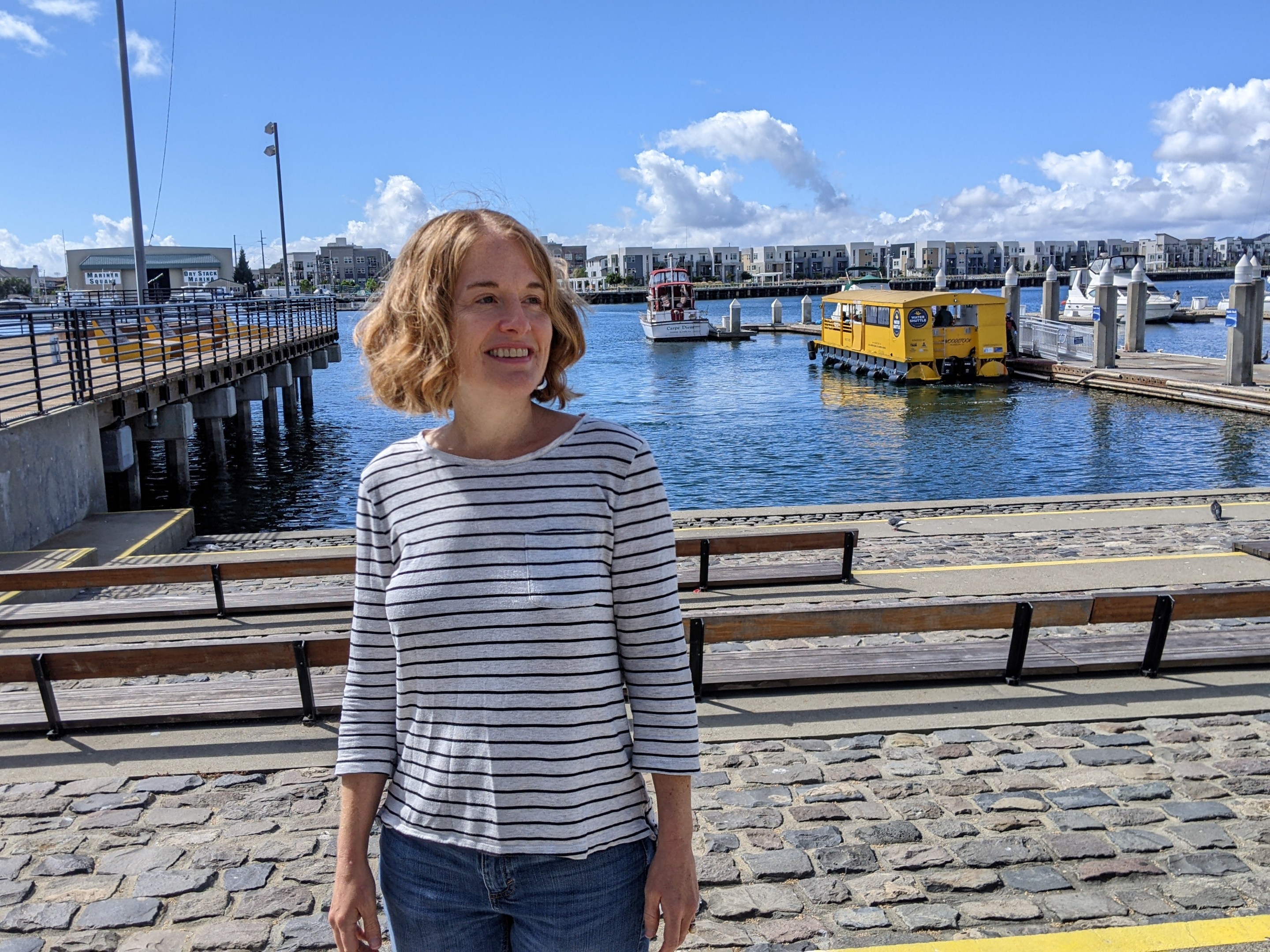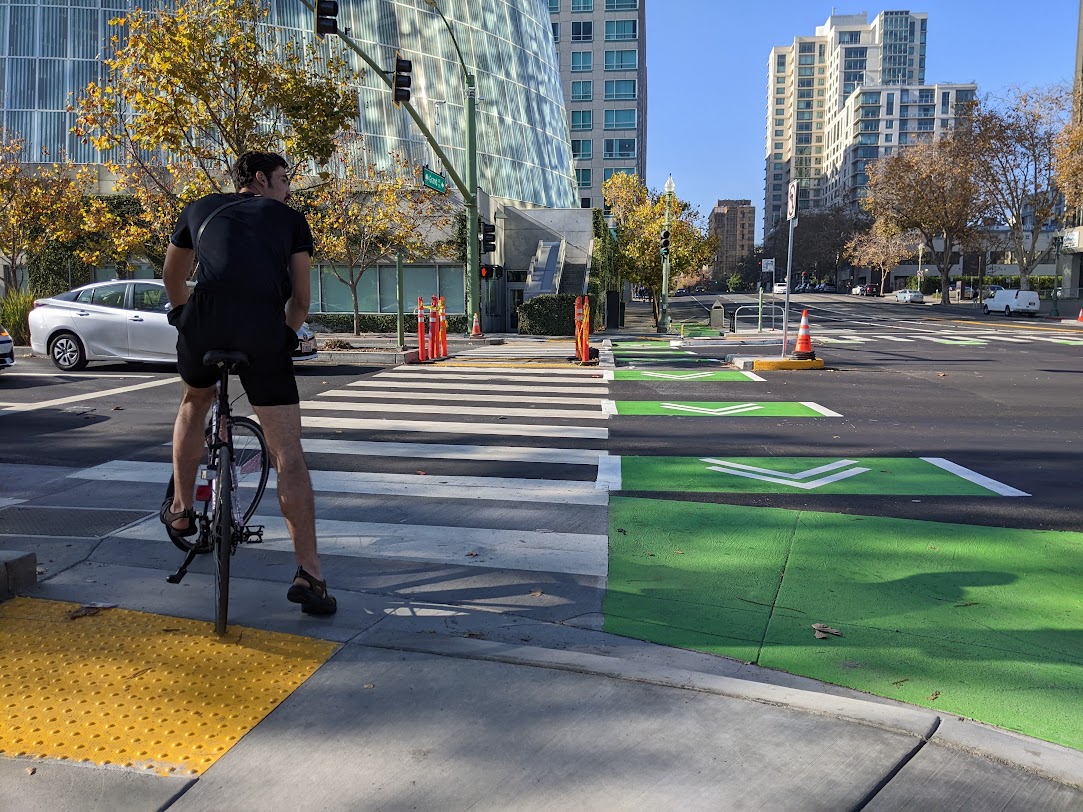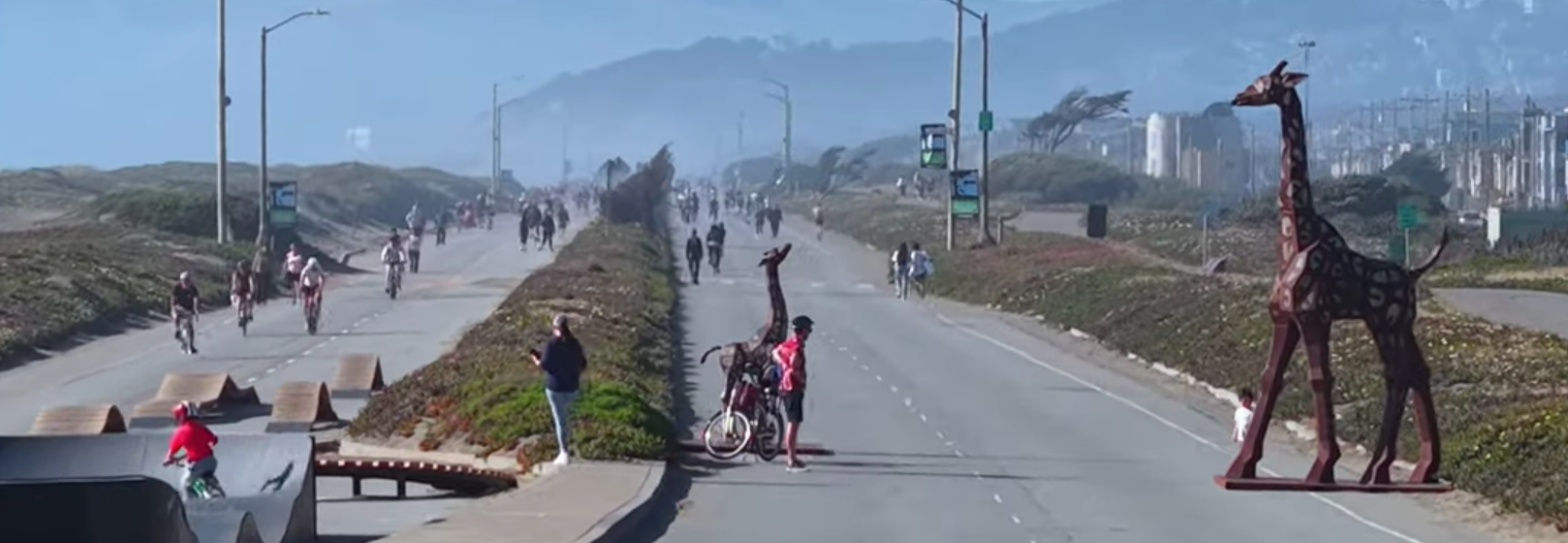Former BART Board Director, El Cerrito Councilmember, and long-time professional bicycle advocate with Bike East Bay (BEB), Rebecca Saltzman is a force of nature in the advocacy community. She's even a winner of the highly coveted Super Streetsie award! When she was recently promoted to Co-Executive Director of BEB, Streetsblog thought it would be a good excuse to catch up on her years of advocacy work with an interview.
***
Streetsblog: So wait, did you just say you're shopping for an e-bike but you don't currently own a bike?
Rebecca Saltzman: I consider myself an advocate for getting around without a car. One of the many things I love about BEB is that it looks at things holistically. It's not just about bikes. If you bike, you are also a pedestrian and a transit rider. Obviously, BEB is centered on biking, but it also advocates for transit and walking.
SB: Right. Because a street properly designed to accommodate cycling has to accommodate walking and transit as well.
RS: I used to have a bike, but I never used it as transportation. I get around by walking, transit, and sometimes by car. The reason I'm looking for an e-bike now is that my daughter didn’t get into our neighborhood school in El Cerrito, which is a 12-minute walk. There’s no bus to get to the other school, which is a 45-minute walk, so we’re now shopping for an e-bike. That’s going to be a process.
SB: And you drive in the meantime. What was wrong with the bus?
RS: I looked at that. It would take over an hour and a half with two buses. And the bus runs once an hour, so if you miss one...
SB: Yeah, that doesn't work. How long is the drive?
RS: Ten minutes. Straight uphill. The school is close. But pretty much everybody drives. This is how we built places and why our transit is so poor.
SB: So how does a family that can't drive, or can't afford a car, get their kids to school? What's with the school boards that they assign students to schools they can't get to?
RS: They’re assuming everyone has access to a car. Or you could say it assumes you have safe bike lanes, which we don’t.
SB: But you're working on it.
RS: (Nods). For now the side roads are decent options.
SB: But that says tons about people who may not be mentally wired into the whole safe-streets advocacy community. They are going to just decide to be in a car. Anyway, so now that BEB is expanding from two to three directors, I wonder how you settle disagreements? Does someone have veto power?
RS: We talk through things. Everyone has their areas of expertise and we tend to stay in our lanes.
SB: But what if...
RS: Maybe we’d have a vote. Or we’d bring it to the board or the staff. There’d be a way.
SB: What about from the membership? You must occasionally have disagreements with the many members?
RS: Sometimes we get flak on things, but we’re pretty strong on where we’re going.
SB: Anything come to mind?
RS: The most recent one was our advocacy around police chases. Some people think our position is that the police never go after criminals. But it was recognizing this is a real street safety issue, and we have to make sure people stay safe, so what are the guardrails on it? We have been advocating for the police to maintain the rules they already have, because there was a conversation on how fast they could go, and what crimes they could pursue. The commission just made a decision, and they changed it a little bit. We’ll see how it works out.
SB: We've written about your work to get BART more bike-friendly. Most recently, as a BART board director, you helped change the rules so bikes can go on escalators. I wonder what makes this so difficult in the first place, why it's such a heavy lift to accommodate bikes on transit when it's such a natural synergy. I mean, Muni in San Francisco still has a blanket bike ban on Muni rail.
RS: I can’t speak for Muni, but just speaking from being on the BART board, I think at big institutions, change is hard. Or maybe it's just in society. People get stuck in the way things have been done and every change feels potentially catastrophic. Back in 2013, when we changed it to allow bikes on BART at all times, there was consternation. BART was starting to get really crowded, and people thought that allowing bikes would deter people from riding the trains. We'd get emails from annoyed riders, saying they won’t be able to ride BART with those dirty bikes. Or they'd write that "I’ve been hit by a bike" or "somebody knocked into me with a bike."
SB: Pretty irrational.
RS: It's just like people who oppose housing. But we also got hundreds of letters from people who want it. And then we implemented it. And we didn't get many complaints at all, and even then, it was just for a couple of weeks.
SB: And now nobody cares.
RS: And the new trains have even better dedicated space for bikes. But it took years. BART directors Tom Radulovich and Robert Raburn started working on that in 2012 or 2011.
SB: And now we have bike lockers, racks, and bike-share stations. Integrating biking and BART trips is easier than ever. There are even bike stairway channels at a few stations. Actually, why is that so rare?
RS: There's the cost of retrofitting stairs and, now that bikes are permitted on escalators, I don't think there's a push to make it happen anymore. Speaking of escalators, I smile every time I see a bike on an escalator.
SB: Thank you for helping to make that happen. So has anyone dropped a bike on an escalator yet?
RS: Robert Raburn asked staff to account for all escalator injuries. The number one cause is luggage, not bikes. So you can drop anything on an escalator, but it’s very, very rare.
SB: I remember an argument you once had with Bevan Dufty a few years ago on the BART Board about the location of the bike-share station at 24th and Mission BART. He was willing to allow the bike-share to be a couple of blocks from BART rather than in the station plaza after objections based on... well, I'm not sure what, gentrification? You felt it was super important to have it right there in the station plaza when you come up the escalators. What can people learn from that interaction? What's a word of wisdom about that?
RS: Honestly, it comes back to the fact that people are scared of change. There was this thought that having a bike-share right by the station would make it less of a gathering space.
SB: I seem to recall during the debate you pointed out the difference between a man and a woman contemplating using a bike-share, when it means having to walk an additional block late at night.
RS: This is something that is not thought about enough in transportation planning. There are all sorts of barriers to biking and using transit. And one of those is the idea of being out at night alone; how comfortable you are when making a decision between using transit, biking, or taking an Uber or a Lyft. I’ve talked to plenty of people who take Uber or Lyft at night because of safety concerns. We need to make our cities feel safe, have good lighting, have people around, but also we must make it very easy to make connections between buses, bikes, and transit.
SB: I think it also just helps to get to the top of the stairs and see the bike station.
RS: Right. It’s the visibility. You have to get things right in front of people sometimes to get them to use it. They might see it ten times before they decide to use a bike-share instead of a Lyft to connect to and from BART.
SB: Tell me your three favorite projects in the East Bay.
RS: There are so many! Finished? Planned?
SB: Doesn't matter.
RS: Then I guess my top one hasn't even started. The San Pablo corridor—
SB: Hasn't started? (Grinning) You know, there's a section in this city called El Cerrito?
RS: Yes, that's started. But I'm speaking of the whole San Pablo corridor. At BEB we deal with all sorts of projects on a very macro and very micro level, but often half-mile projects, while nice, don't form a network. And when we're convincing people to ride bikes, we need a whole network and long lengths of streets that don't end at arbitrary city borders. People don't just live in Oakland, or Emeryville, or Berkeley, or Albany, or El Cerrito. But that's what's so exciting about San Pablo Avenue, because it's a street where all the cities are building housing. There's already lots of retail. It's a corridor where people want to live. But for people biking, trying to use the bus, or walking, well, most of the intersections are just not places I want to cross.
SB: So if it all gets done, we'll have a safe bike and bus spine through the western part of the East Bay.
RS: This project really improves it for everybody, but it’s going to take a long time. El Cerrito will open later this year, then we have plans for Oakland and Emeryville and a tiny part of Berkeley. And we’re just starting to do the real planning for the rest of the corridor.
SB: Another project?
RS: One that comes to mind is 14th Street in Oakland. It's funny because 14th never had a ton of car traffic, but because of that, drivers went very, very fast. Oakland put in a lot of attention to detail about how people on 14th will navigate bus stops, with raised and separated platforms.
SB: That project is really coming along. Your third project?
RS: We have a ribbon-cutting tomorrow in Berkeley.
SB: Right. The bike and bus lanes around the campus.
RS: I went to U.C. Berkeley and getting around by walking and transit was treacherous. You have all these multi-lane traffic sewers and drivers fly down there, despite the fact that so many people are walking and biking.
SB: Sharrows—bullshit or better than nothing?
RS: Sharrows on any streets with any kind of serious car traffic are bullshit. But I think the question is what kind of street? If it's a bike boulevard, I don’t know if sharrows do anything on their own, but there are streets where you don’t need a protected bike lane. I’ve had many conversations about that in El Cerrito with people who didn’t want to lose their parking, and they say, "can’t we just have sharrows?" on an inappropriate street. And I say, "we have new knowledge that they don’t work and can actually make it less safe."
SB: Who's your favorite politician, living or dead, local or not?
RS: I don’t think I have a favorite one. We have a lot of great ones locally.
SB: Then what characterizes them?
RS: I think somebody who is both out there in the community and listening to people and willing to talk to folks, but also has standards they believe in. The fact is, you can't always go down the middle of the road and always worry if you’re making somebody mad. If that's the case, you're also not getting anything real done.
SB: What else?
RS: Politicians who pay attention to the details. There's real power in reading your full agenda packet or getting your detailed briefing from staff.
SB: Anything we didn't cover or you want to talk about more?
RS: Getting back to the co-executive director part, we’ve been blown away by the response we’ve been getting. We’ve received zero negative feedback, and many people have reached out to tell us their stories about burning out after a few years.
SB: At other advocacy orgs? It does seem as if I've seen way too many people come and go.
RS: As a director, there are nighttime events, Jill, Justin, and I all have young kids. It's just not feasible for a smaller non-profit to have one director, given the demands. It’s extremely challenging. They feel as if they have to work 60 hours a week.
SB: And often they actually do.
RS: I couldn’t be an El Cerrito City Councilmember, a mom, and the only executive director of BEB. I mean, I could, but it'd be horrific. It'd be terrible for one's mental and physical health. It's just not sustainable.
SB: Well, let's hope other non-profits try it out too. Thanks for your time, Rebecca. Good luck in the new gig.
RS: Thanks.





